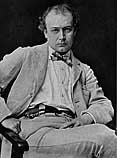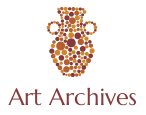Charles Walter Stetson
 Charles Walter Stetson, landscape, portrait and mural painter and etcher, was born March 25, 1858 in Tiverton Four Corners, Rhode Island. In 1869 the Stetson family settled in Providence. Self-taught as an artist-there being no possibility of training in art in Providence at that time-by 1872 Stetson had begun to color. By 1878, when he opened his first studio in Providence at the age of twenty, Stetson had followed his early Ruskinian landscapes by a broader, coloristic technique. His paintings were accepted into exhibitions at the Pennsylvania Academy and Boston Art Club, attracting the praise of prominent artists and critics of the time. In the early 1880s, Stetson became attracted to Venetian old masters, which he encountered in New York, having seen nothing in art except reproductions until this time. Around 1882 Stetson taught himself etching and learned both French and German. It was in this year as well that Stetson was to have his first one-man exhibition at the Providence Art Club, of which he was one of the founding members. 1882 was also the year in which Stetson married Charlotte Anna Perkins, who, in later years, was to distinguish herself as an author and feminist lecturer. In 1885 their daughter, Katharine Beecher Stetson, was born. The artist made his first trip to southern California in 1888 and made his home there with his wife and daughter until 1890, when he returned to New England to be with his mother during her last illness. In 1892 he divorced Charlotte and in 1894 he and her first cousin, the poet Grace Ellery Channing, married. In that year Stetson and Grace moved to Pasadena, California and resided there until 1901. Stetson made his first visit to Europe in 1897, where he visited Holland, Belgium, France, Germany, England and Italy; upon his return to Boston, his health broke down. From 1901 to 1911, Stetson made his home in Rome; during 1909-10 his summers were spent at Viareggio and Capri. Deafness and illness kept him isolated from fellow artists, except for the American painter Elihu Vedder, by whom he was befriended. Stetson most frequently worked as a landscapist and figure painter and watercolorist, particularly concentrating on imaginative themes. In Rome he was invited to the Venice Biennale, in 1904 to the Rome International, and again in 1911 to the Rome International. He died in Rome on July 21, 1911 owing to the aftereffects of an operation. In 1912 there was a Memorial Exhibition of his work shown at the Museum of Fine Arts, Boston; similar Memorial Exhibitions were shown at the Detroit Museum of Art in 1913 and at the Metropolitan Museum, New York, in 1914. Several works in this Catalog bear the labels from these Exhibitions. "After the Bath", one of his last works, was recently acquired by the National Museum of American Art, Washington, D.C.
Charles Walter Stetson, landscape, portrait and mural painter and etcher, was born March 25, 1858 in Tiverton Four Corners, Rhode Island. In 1869 the Stetson family settled in Providence. Self-taught as an artist-there being no possibility of training in art in Providence at that time-by 1872 Stetson had begun to color. By 1878, when he opened his first studio in Providence at the age of twenty, Stetson had followed his early Ruskinian landscapes by a broader, coloristic technique. His paintings were accepted into exhibitions at the Pennsylvania Academy and Boston Art Club, attracting the praise of prominent artists and critics of the time. In the early 1880s, Stetson became attracted to Venetian old masters, which he encountered in New York, having seen nothing in art except reproductions until this time. Around 1882 Stetson taught himself etching and learned both French and German. It was in this year as well that Stetson was to have his first one-man exhibition at the Providence Art Club, of which he was one of the founding members. 1882 was also the year in which Stetson married Charlotte Anna Perkins, who, in later years, was to distinguish herself as an author and feminist lecturer. In 1885 their daughter, Katharine Beecher Stetson, was born. The artist made his first trip to southern California in 1888 and made his home there with his wife and daughter until 1890, when he returned to New England to be with his mother during her last illness. In 1892 he divorced Charlotte and in 1894 he and her first cousin, the poet Grace Ellery Channing, married. In that year Stetson and Grace moved to Pasadena, California and resided there until 1901. Stetson made his first visit to Europe in 1897, where he visited Holland, Belgium, France, Germany, England and Italy; upon his return to Boston, his health broke down. From 1901 to 1911, Stetson made his home in Rome; during 1909-10 his summers were spent at Viareggio and Capri. Deafness and illness kept him isolated from fellow artists, except for the American painter Elihu Vedder, by whom he was befriended. Stetson most frequently worked as a landscapist and figure painter and watercolorist, particularly concentrating on imaginative themes. In Rome he was invited to the Venice Biennale, in 1904 to the Rome International, and again in 1911 to the Rome International. He died in Rome on July 21, 1911 owing to the aftereffects of an operation. In 1912 there was a Memorial Exhibition of his work shown at the Museum of Fine Arts, Boston; similar Memorial Exhibitions were shown at the Detroit Museum of Art in 1913 and at the Metropolitan Museum, New York, in 1914. Several works in this Catalog bear the labels from these Exhibitions. "After the Bath", one of his last works, was recently acquired by the National Museum of American Art, Washington, D.C.
BIBLIOGRAPHY
Channing-Stetson, Grace Ellery (text). Detroit Museum of Art, Memorial Exhibition, 1913.
Eldredge, C. C., American Imagination and Symbolist Painting. New York, 1979.
Eldredge, C. C., Charles Walter Stetson: Color and Fantasy. Lawrence, KS, 1982.
Gerdts, William H., Art Across America: Two Centuries of Regional Painting. 3 volumes. NY, 1990.
Hill, M. A. (ed). Endure: The Diaries of Charles Walter Stetson. Philadelphia, 1985.
Knight, Denise D. (ed). The Diaries of Charlotte Perkins Gilman. 2 volumes. Charlottesville: University Press of Virginia, 1994.
Moure, Nancy Dustin Wall, Loners, Mavericks and Dreamers: Art in Los Angeles Before 1900. Laguna Beach, CA,1993.
Soria, R., Dictionary of Nineteenth-Century American Artists in Italy: 1760-1914. NJ, 1982.

